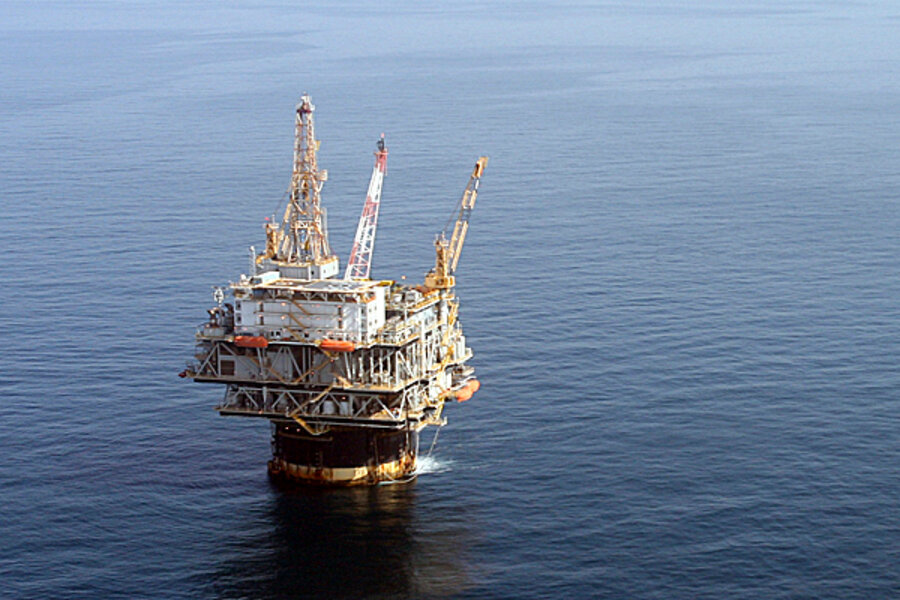Obama seeks compromise in offshore drilling plan
Loading...
Offshore oil and gas drilling will move ahead in Atlantic waters from Virginia to mid-Florida, westward in the Gulf of Mexico from125 miles off Florida's coast, and off parts of Alaska's northern coast, President Obama announced Wednesday.
However, the Pacific coast will remain off-limits to offshore drilling, as will the environmentally sensitive salmon fisheries of Bristol Bay, Alaska, and the heavily fished waters north of Delaware through New England, the president said.
Mr. Obama's announcement came as a court order required the Department of the Interior to resolve offshore oil lease questions in Alaska by today.
It also comes as supporters of a compromise plan for comprehensive climate and energy legislation in the Senate are hoping to pass legislation by late spring – before summer recess and the fall political season.
Republicans also have been waging a campaign to pressure the White House to allow offshore oil and gas development nationwide.
"Today we’re announcing the expansion of offshore oil and gas exploration – but in ways that balance the need to harness domestic energy resources and the need to protect America’s natural resources," Obama said in his prepared remarks.
Some environmentalists say that the president has betrayed his renewable-energy and environmental credentials. A few oil industry groups gave the announcement tepid support. But industry backers in Congress said the move fell far short of opening the the nation's offshore waters for energy development.
The president noted that his steps were sure to displease many, but the move was a compromise plan to boost domestic energy production in the interim before renewable energy was widely available, while creating jobs and still protecting the environment.
The effect on energy independence
Advocates of American energy independence were skeptical that the plan would have a significant impact.
"This won't do anything really significant to boost US energy independence," says Gal Luft, executive director of the Institute for the Analysis of Global Security in Washington. "It doesn't address the core energy security issues we have – that is the monopoly of oil in the transport fuel sector."
The move opens for leasing and exploration eight areas that could represent as much as 80 percent of the undiscovered economically recoverable oil and gas on the US outer continental shelf, said Secretary of the Interior Ken Salazar.
“Our efforts to strategically open new areas in the eastern Gulf would represent the largest expansion of our nation’s available offshore oil and gas supplies in three decades,” said Mr. Salazar.
Interest in drilling in the fish-rich Georges Bank off the coast of Massachusetts led to the first drilling moratorium in 1981. Bipartisan support existed in Congress for the nationwide moratorium on offshore drilling until 2008 when, with gas prices approaching $4 a gallon, Congress allowed the moratorium to lapse.
But Obama's announcement may be historic, too, some say.
"History will judge this as a step down a path toward continuing dependency on fossil fuels and a decision to create sacrifice zones in long protected areas," says Richard Charter, senior policy adviser for marine programs at Defenders of Wildlife.
Mixed reaction from environmental groups
The presidential move created a clear split within the environmental community.
For some, the saving of key areas like Bristol Bay was critical.
In 2007, the Bush administration lifted a drilling moratorium in Bristol Bay – home to the world’s largest wild sockeye salmon run, the endangered North Pacific Right whale, the Steller sea lion, and huge numbers of seabirds. It proposed that 5.6 million acres, about one-fifth of the bay, be leased for drilling.
So taking it off the table was a big step, some observers say.
For others, the president's move sacrificed the environment as a political sop to oil and gas interests.
"It makes no sense to threaten the East Coast of America with spills and other drilling disasters when we’re about to unleash the real solutions to oil dependence -- cleaner cars and cleaner fuels,” said Anna Aurilio, director of the Washington office of Environment America in a prepared statement.
This may not be the final word
Close watchers of the president's energy plans and Senate actions on energy say that despite appearances that the president had opened a lot of new waters to drilling, much remained to be done to make that a reality. The sharing of oil revenue from offshore drilling with the states, for instance, was not addressed.
That might leave some incentives for pro-drilling senators to move toward compromise on climate-energy legislation.
The president was trying to thread a political needle, holding out promise of more drilling to potential Republican backers of comprehensive energy legislation, while not alienating Democrats, says Kevin Book a partner at ClearView Energy Partners, a Washington-based energy consulting firm.
"But states still control their shorelines," he added. "So without revenue sharing, we're still a long way from drilling."






